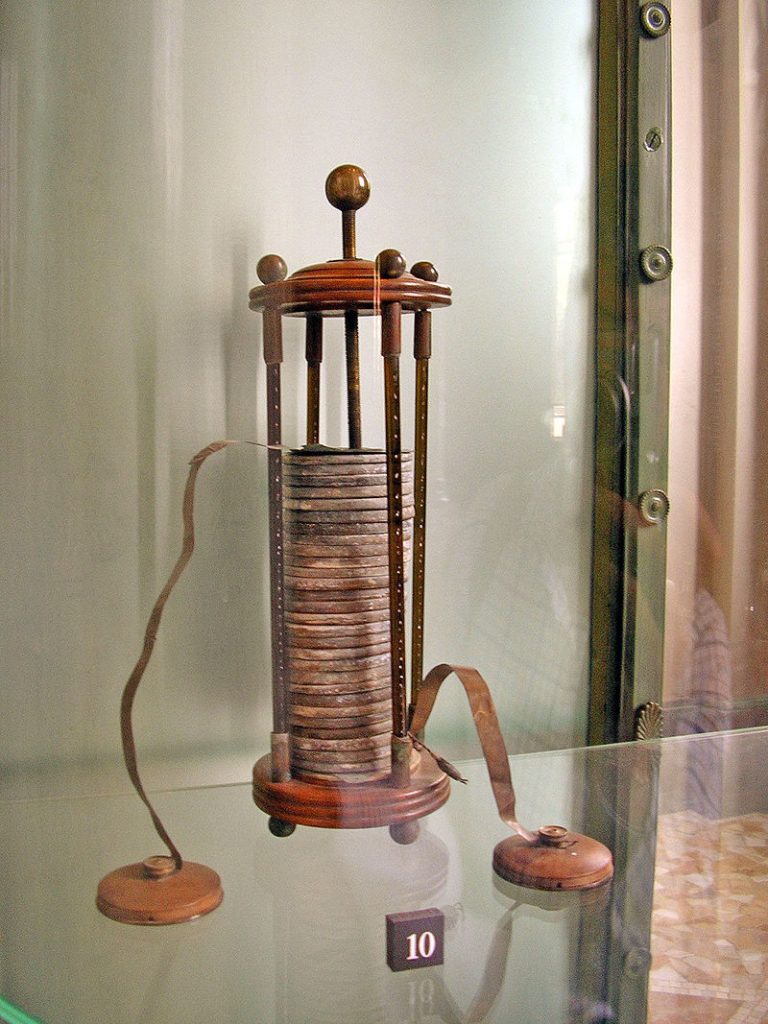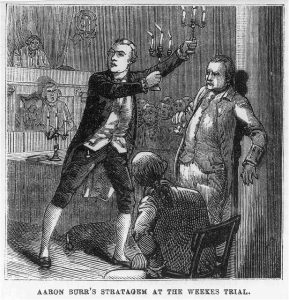Can you imagine a day without a battery? All our devices from smartphones to pacemakers use the power of batteries to harness electricity. These devices play a pivotal role in our society and it is important to give credit where credit is due. You can thank the great Italian scientist Alessandro Volta for his discovery of the first ever battery coined the voltaic pile. If his name sounds a bit familiar it is because the volt (unit for electric potential) is named after him.

Alessandro Volta was born to an aristocratic family in Como, Italy on February 18th, 1745.1 Volta excelled in math and science at a very young age. Even as a school boy he showed a keen interest in electricity. In the eighteenth century, the phenomenon of electricity was an intellectual curiosity, and not much was known about its properties. Volta excelled in school, and in 1774 he became a professor of physics at the Royal School of Como.2 During his time as professor, his interest in electricity remained a focus of his work. He created the electrophorus, which was a device used to generate static electricity.
Volta never set out to invent the battery. His experiments on electricity were in response to the claims of a scientist and friend of his, who claimed to have found electricity in animals.3 This scientist was Luigi Galvani, a professor of anatomy at the University of Bologna. One day as Galvani was performing an experiment on frogs, he began to cut the legs so that they would be exposed. When he touched his steel scalpel with a brass hook holding the frog’s legs in place, he saw the legs twitch. Galvani was convinced that what was going on was the presence of animal electricity. Galvani thought the muscles of the frog stored its life force. When Volta learned about Galvani’s discovery of animal electricity, he went right away to try to replicate Galvani’s experiment. Volta wanted to see for his own eyes what Galvani had published to the scientific community about his new discovery. After completing the experiment dozens of times, Volta disagreed with Galvani. Volta believed that the movement of the frog legs were because of the electric stimulation that was provided by the steel scalpel and the brass hook.4 Volta concluded that the frog’s legs were merely a vessel for the electric stimulation.

Once Volta recreated Galvani’s experiment, he knew the key to producing electricity was by using two metals that were not the same and not the actual frog legs themselves. The frog legs could not produce any sort of electricity. The reason the frog legs would move was because of the charge which was sent through the frog legs and into the nerves inside the legs which in turn resulted in a twitch. This was an indication that electricity was present. Volta recreated the experiment but would later conclude the frog legs were not the only electricity indicators but so were other materials such as moist cards of brine, or cardboard soaked in salt water. This was when Galvani concluded that the electric charge came from the rods of metal themselves and had nothing to do with frog legs. For the first experiment he used five cups with brine or salt water in them. Then, by adding pieces of silver and zinc, he attached the cups by metal strips where he placed them into the cups of brine. He would then put one finger at each end of the cups to feel the slight electric shock. Impressed with his work, he wanted to see if he could recreate his experiment, but without all the brine water. He then created a circuit consisting of copper and zinc discs that were separated by a cardboard soaked in brine. Just by adding more copper, cardboard soaked in brine, and zinc, Volta was able to adjust the amount of electricity that was being produced by the circuit. This became the voltaic pile, the first battery with a reliable source of electricity. Once Volta realized what he had done, he was able to refute the idea Galvani proposed about animal electricity.

Volta published his experiment and findings to the scientific community and later was honored for his invention of the voltaic pile. Today it is now almost impossible to not be in constant contact with a battery. You can thank Alessandro Volta for his discovery of the battery, which became a template for our modern dry-cell batteries. We might also thank Luigi Galvani for his role in stimulating Volta’s experiments, and maybe even thank the many nameless frogs for their contributions.
- Oliver J. Thatcher, The Library of Original Sources (New York, Chicago: University Research Extension, 1907), 395. ↵
- Encyclopedia of World Biography, 2004, s.v. “Alessandro Volta,” by Paula K. Byers. ↵
- Joost Mertens, “Shocks and Sparks: The Voltaic Pile as a Demonstration Device,” The History of Science Society 89, no. 2 (June 1998): 303. ↵
- Giuliano Pancaldi, Volta: Science and Culture in the Age of Enlightenment (Princeton University Press, May 1, 2005), 110. ↵



51 comments
Mario Sosa
A lot of us – myself included – just assumed that batteries were invented by well-known late 19th century scientists like Thomas Edison and Nikola Tesla. Never would I have thought that frog legs would lead to the invention of batteries. What was the most surprising to me was that the battery’s invention was in the 18th century, as I figured that it would have been created alongside with many of Edison or Tesla’s inventions. Fascinating article, great job!
Evelin Joseph
It is amazing that something as normal and ordinary as frog legs have brought about an invention that changed the world as we know it. Alessandro Volta seemed to be an exceptionally smart physicist as he discovered the electricity that was present in the metal rods connected to the frog legs. Through various trials and experiments he was able to create the first of many batteries, the voltaic pile, and change history forever. Overall, the article was eye-catching and enjoyable. I learned a lot from it including who created the battery and his inspiration behind it.
Justin Garcia
This is a very interesting article. It just goes to show that some of your best work can happen when you least expect it. The fact that we now have batteries due to an experiment on frogs is astonishing. The article also does well to inform the readers about Volta’s life in a straightforward manner. Overall this was a very well written article.
Andrea Chavez
The title is very good, quite eye-catching. It is interesting to see the patterns in discoveries throughout history. In this case I like that his objective was not the batter, but in the process of his inventions he created something really important. Which I think is very beautiful in its own way the way you get to discover what you have created by “accident” or out of “luck”.
Josselyn Arrieta-Meraz
Who would have thought that because of a frogs leg someone came up with the idea of the essential part of modern life, a battery. The journey Volta took was really interesting to read his process and success, the fact that something about his name sounded familiar, later I came to the connection Volta=Volts which is the potency of a battery. And yes I agree to pay homage to Galvani, Volta and the many frogs who were sacrificed.
Manuel Aguilera
I have never considered who actually created the battery. I like how the story of the creation of the battery follows the same path of a lot of inventions, obviously with specific factors that could drive it, a man was experimenting with different variables and would eventually reach a point where he realized that he discovered something groundbreaking. Currently, I have not seen/heard of much originality in new scientific discoveries, as this story reflects much more.
Teresa Valdez
The title of the article is great, really eye-catching. The introduction is also really good, it really draws the reader in. The narrative of this article is very compelling. It is hard to believe that at one point scientists believed that there was such a thing as animal electricity. To think that science has advanced so much, but we still use Volta’s concept is awesome.
Mark Martinez
A extremely well written and put together article that was interesting to read. Honestly, I take the battery for granted and forget how many items I have that need one to function. The fact that Alessandro Volta never intended to make a battery but to follow up on an experiment from his friend kind of blows my mind. If Volt had believed the experiment and not tested it there would be know batteries today.
Alexis Renteria
I didn’t have a clue of how the battery was created and by who. Coming across this article i learned about Alessandro Volta and his accomplishments growing up. I found it a little humorous how at first Alessandro thought that he found electricity because of the frog legs, but then figured out that the electricity came from the other materials. Overall, this article was very interesting and I’m glad that i now know who the person was behind the invention of the battery, and how it was discovered.
Maria Callejas
Awesome title! It grabbed my attention the second I laid eyes on it. You maintain that engaging thrill even in your introduction, highlighting the importance of batteries in our lives. You chose a great topic, as it was a total learning experience, so thank you for that! It is interesting to see how Galvani thought that the electricity came from the frog legs, good thing that Volta came along and proved that was not the case. Great job!